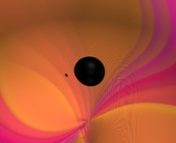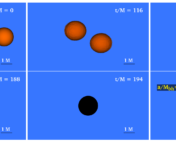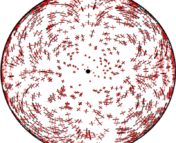Paper Title: Source confusion from neutron star binaries in ground-based gravitational wave detectors is minimal
Authors: Aaron D. Johnson, Katerina Chatziioannou, and Will M. Farr
First-author institution: Department of Physics, California Institute of Technology, Pasadena, California
Status: Published in Physical Review D [Closed Access]
On February 11th, 2016, The LIGO (Laser Interferometer Gravitational-Wave Observatory) and Virgo collaborations announced the first ever confirmed detection of gravitational waves. This detection–created by the final inspiralling and eventual merger of a pair of black holes–ushered in a new era of multi-messenger astrophysical research. In the years since, many more observations of and uses for gravitational wave studies have been established. The astronomy community is deeply invested in the future of gravitational wave research. Of particular note is the forthcoming, space-based LISA (Laser Interferometer Space Antenna) mission. Additionally, astronomers are looking forward to the next-generation upgrades on the existing LIGO and Virgo observatories.
Today’s paper highlights the upcoming improvements to LIGO and Virgo, taking a prospective look into potential future observing difficulties. The planned improvements to these observatories will increase both the sensitivity of the instruments, as well as the frequency range of possible observations, but also increase the concern of source confusion.
What is Source Confusion?
While LIGO and Virgo are astronomical observatories, they vary significantly from standard telescopes in a number of ways. While a normal telescope can be pointed at a particular source or set of nearby sources, interferometric detectors are passive, and wait for gravitational waves to pass by. In this way, LIGO and Virgo are constantly observing the entire sky all at once. This is great for catching transient events like inspiralling compact objects, but can create problems if two gravitational wave signals reach the interferometers simultaneously. “Source confusion” (or “signal confusion”) is said to occur when two gravitational wave signals with overlapping frequency ranges are observed simultaneously. The increased range of the next-gen gravitational wave observatories means that we expect to see a higher rate of gravitational wave events, increasing the likelihood for source confusion.
Today’s paper aims to address two questions related to the source confusion problem. 1. How often might we expect to see signals with time-frequency overlap? And 2. To what extent does time-frequency overlap impact our ability to estimate the features (or parameters) of the source systems? For both, the authors make use of simulated data based on existing parameter distributions from observed Binary Neutron Stars (BNSs) and Binary Black Holes (BBHs).
Time-Frequency Overlap
In order to quantify how often time-frequency overlaps may occur, today’s paper begins by calculating the number of expected observable mergers. Because BNS mergers are more common than BBHs or Neutron Star-Black Hole (NSBH) mergers, they focus on calculating signal overlap for BNS mergers only, with the understanding that the effect will be lessened in the other cases. For a set of merger frequencies ranging from 20-1700 mergers/Gpc3/yr, they calculate the expected average length of time between individual mergers. From here, they are able to model several days’ worth of mergers, and plot all the merger signals in time-frequency space.
It is important to highlight that, in order for source confusion to be of concern, merger signals need to overlap in time and frequency. For each simulated merger, the authors calculate the cumulative number of time-frequency crossings that occur as a function of frequency. In doing so, they identify that the majority of time-frequency crossings occur at lower frequencies. This is expected, as the strong frequency evolution of BNSs increases as the merger speeds up, so they spend less time at higher frequencies.
Impact on Analysis
Next, in order to address the second question, the authors simulate a single time-frequency crossing of two mergers, varying the system parameters of both. They are then able to analyze the simulation output as they would a real merger signal, attempting to identify the target system parameters from the now-messy signal. The goal is to compare with similar simulations of a single target merger, and determine how much the time-frequency crossing impacts the uncertainty in parameter values obtained from the analysis. For this purpose, the authors define an uncertainty ratio. The closer this ratio is to 1, the less impact the overlapping signals have on the analysis of merger systems.
The authors then plot the uncertainty ratios for a number of parameters as a function of the difference in chirp mass (a value used to assess the relative masses of the objects in the binary) of the crossing sources. They find that the uncertainty ratio becomes much more relevant for all parameters when the chirp masses of the sources are most similar.
Conclusion
As gravitational wave detectors improve, we expect to be able to observe merger events at a higher rate. As a result, it is important to understand the potential negative effects of source confusion, when two merger signals cross in time-frequency space. Today’s paper focuses on understanding how often (and at what source frequencies) we can expect source confusion, and how strong an impact it may have on the modeling and analysis of merger systems. In the end, the authors find that 91% of time-frequency overlaps occur at relatively low (<5 Hz) frequencies, a result of the strong frequency evolution of these systems. In cases where overlaps occur, the effect on parameter uncertainty is minimal–less than 1% in greater than 99.86% of cases. Our merger event parameters obtained from LIGO and Virgo aren’t going to be unreliable any time soon.
Astrobite edited by Erica Sawczynec
Featured image credit: NASA/GSFC




